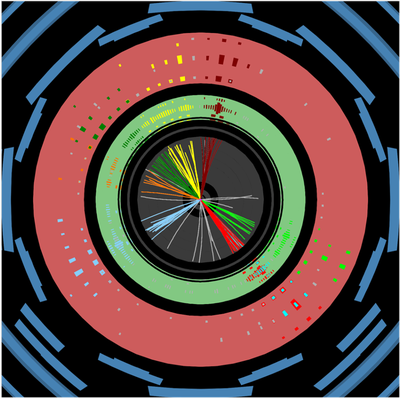ATLAS performance
Reconstructing jets

Due to the structure of the strong interactions, when highly energetic quarks or gluons are produced in particle collisions they produce a collimated spray of particles. Combining the signatures of all detectors of the ATLAS experiment can reconstruct this spray of particles as a single object, a jet. We are studying the properties of these jets to achieve the most precise measurement of the quark and gluon momenta and energies.
The picture shows different signatures in the ATLAS calorimeters (red and green rings) and tracker (innermost grey area). By a grouping algorithm, jets can be reconstructed, indicated by the different colour of the detector signatures.
Identifying b-jets and Higgs jets

Our research program focuses on the Higgs to bb channel and the identification of Higgs pairs decaying to b-quarks relies on the reconstruction of b-quark jets. Due to the relatively high mass of the b-quark, there exists a long-lived particle within the jet (the B hadron) that decays after travelling a few millimetres through the detector. This allows us to identify b-jets by looking for displaced tracks or secondary vertices within a jet, see also the sketch here.
In case of an energetic Higgs boson decay into two b-(anti)quarks, this pair can be so collimated, that they can be reconstructed as a single boosted jet. This is why our group not only studies the identification of b-jets but also particularly of boosted Higgs jets.
